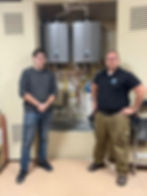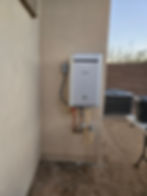


This was a re-install of someone else's improper installation. Hot & Cold valves now in the correct location; difficult soldering job came out great; PVC drip line isolated & moved to the side; safety-release valve now attached to proper CPVC Pipe & on its own dedicated line


Tankless Water Heaters
* used in Europe since the 1970's
* save space, save energy, and never run out of hot water [Federal tax rebates often available]
* last a really long time- 25 years or more is common, as long as you perform regular maintenance
Maintenance Requirements
* Inspection: 1 Year After Install (Very important to see how everything is working)
* After that every 2 years is fine, unless there is very high usage and/or no water softener
* consists of a 45-minute de-scale / de-lime flush & a 5-point inspection
* cost for this service: $150 per unit
* additional maintenance typical pricing (done on an as-needed basis):
Fan service $50; Flame Rod service $50
Isolation Valve Replacement $400 (frozen valves are common when bi-annual service was not done)
Burner service $250 (rare to actually need burner service)
Pricing - Top of the Line with Recirculation: Rinnai RXP199 or Navien 240A2 - About $4,000...
* Everyone wants to know price. Did you notice that other plumbing companies don't put the pricing on the website? Or they put a cryptic "low price" like "$3400" but they don't tell you which model. This is because it is difficult to predict what the job will cost without doing a full inspection. And there are cheaper models out there, such as those which do not offer recirculation.
* as a general rule, the top-of-the-line units with built-in recirculation, installed in homes with a dedicated recirc line, located inside the garage on exterior walls with good access to venting & drainage, with proper electrical, and nothing else too "weird," are generally in the range of $4,000.
* Now anything else that has to be done is obviously going to cost more. If you need comfort valves, new angle-stops, specialized venting, we have to look at that on a case by case basis. If the wall has to be opened up and large sections of sheetrock have to be removed & replaced, that obviously will cost extra. If we are replacing a large 400-pound 75-gallon standard water heater, those typically cost extra.
* Summary: I know my pricing is significantly lower than the larger companies. I also know that I charge more than uncertified people. Anyone can get a "plumbing license" but that doesn't make you qualified to install a tankless water heater. Certification takes constant training as there are major installation differences not only from one brand to the next, but also from one model to the next even within the same brand. [Example: the piping diagram on the Navien 240-A is totally different than on the newer Navien 240-A2]. New models are constantly coming out so a certification needs to be constantly renewed.
* Protect your investment and demand to see the Rinnai, Navien, or Noritz "accord" (insurance document with each brand clearly listed). That is your proof that the contractor is fully certified & insured, not merely licensed. You can also check the manufacturer's website to see the contractor's name listed under "Certified Installers." There's more to this than soldering two pipes together. Improper installations usually void the manufacturer's warranty.
Electric Tankless:
* we recommend TruTankless Electric Tankless water heaters. Based right here in Scottsdale, Arizona. They are an excellent and relatively inexpensive solution, especially when no gas is available. A typical install runs about $2500 for parts & labor [price does not include required electrical work]. Click HERE to view their website.
Condensing vs Non-Condensing?
* a non-condensing tankless has only one heat exchanger. Cold water passes through it and flame heats it up. The exhaust that comes out is about 400 degrees, so any vapor that might be in it leaves the building as steam. Because of the hot acidic gas that comes out, these need a stainless-steel venting system. As such they are usually a poor choice for retrofits (replacing a regular water heater with tankless). The cons is that they tend to be louder than a condensing unit, use more gas, and make less hot water (about 9gpm max). On the pro side they are cheaper, and you don't have to figure out where the condensate will go. The newest models do come with built-in recirc pumps.
* a condensing tankless has 2 heat exchangers. The first one acts "normal" i.e. water goes through and flame heats it up. It also makes 400 degree exhaust, but instead of throwing this hot gas away, these units recycle it into a second heat exchanger that pre-heats incoming water. The final exhaust is only about 110-130 degrees. For this reason, any acidic condensate in the exhaust will not exit the building it will instead drip back down the exhaust pipe and needs to be collected and removed via a drain pipe. If this acidic vapor touches the galvanized metal of a typical water heater vent it forms a strong acid and will ruin the heat exchanger and void the warranty. For this reason a 2" pvc pipe must be used instead. The cons for these units is that they cost more and we have to figure out where to drain the condensate. On the pro side they are generally quieter and produce more hot water (about 11gpm max). They are more efficient and may qualify for a Federal Rebate (check with your accountant as the rebates tend to change year by year).
Dedicated Recirc Lines vs Comfort Valve System:
* A dedicated recirc line is when the builder brings a return line from the farthest sink back to the location of the water heater and puts a pump on it. In this way hot water is circulated around the line so that the customer doesn't have to wait too long for hot water to arrive. In some cases multiple return lines can be blended into one final exit. I personally like circular systems (similar to the old Radiator steam lines of steam-heated homes). Most manufacturers advise a maximum of 100-feet of return line at 1/2" diameter piping, and up to 200-feet of return line at 3/4" diameter piping. If you do happen to have a large home with only a 1/2" diameter recirc line, it is important to upgrade the line to 3/4" at least from where it exits the wall to the pump, so as not to further restrict the flow. This is because shut-off valves, check valves, and purge valves will restrict a little bit. If you upgrade to 3/4" then even after restriction it will still be larger than the original 1/2" line. A restricted line can cause a recirc pump to burn out prematurely and in general it takes much longer for the water heater to heat the line.
* A comfort valve system is a good alternative when the home doesn't have a dedicated recirc line but the customer wants faster delivery of hot water. This involves placing comfort valves under the furthest sink. In many cases 2 comfort valves need to be used especially when the water heater is in a central location. It is important that the angle stops under the sink be in good working order. Sometimes new supply lines are also needed.
Schedule a quote:
* $100 - There are about 8 different things I have to measure. Fee removed if hired.
* $100 - Diagnostics (if someone else installed it and there is a problem)
More Pics:

Up to 22 gallons per minute (or 14 in the coldest part of the winter) guarantees 3 people can shower at once even while dishes & laundry are being done.




put as many together as needed for unlimited power when you need it- and no wasted energy when you don't.

Put them nice and high so you can increase storage space underneath. Separate controller-keypad can be installed lower for your convenience, and most newer units are controllable through your cell phone.

remove your old water heater & platform to pick up a closet worth of space

We are constantly taking training classes to stay up to date on all the current technologies & techniques.
Point-of-use Commercial Project

old single-faucet standard tank water heater was 12 years old and not performing well; commercial faucet & drain was rotted and rusted.

New Rheem single-faucet Tankless Water Heater installed. 29Amp unit is more powerful than 15A, and makes as fast a flow as expected from standard tanks. New commercial faucet & drain; new stainless steel supply lines. Significant space savings.

ready for another 30 years of service!

